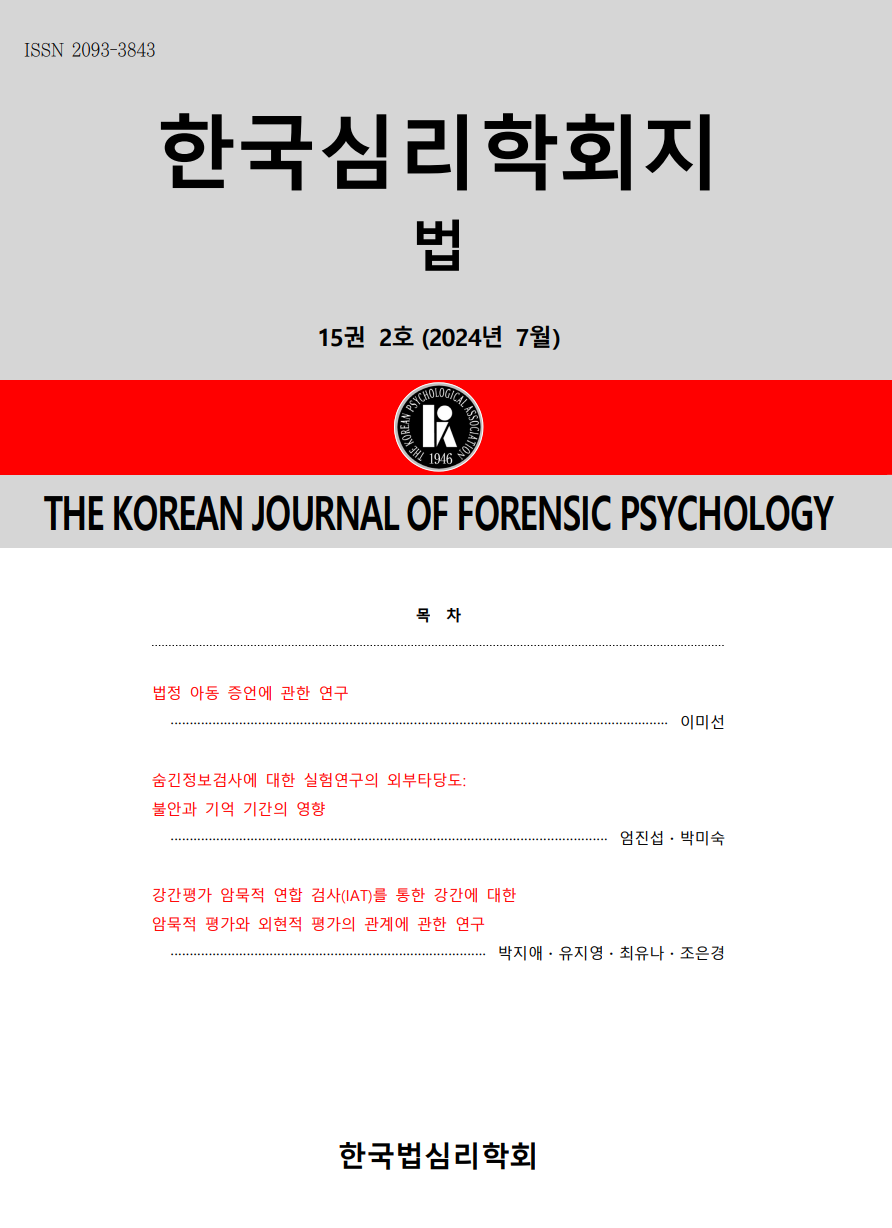 ISSN : 2093-3843
ISSN : 2093-3843
When a person suggests an estimate under uncertainty, (s)he tend to rely on the information and number provided in advance. As a result, their final estimate would be assimilated to the initial value. This phenomenon is called “anchoring effect”. The present research examined anchoring effects observed in law courts. Sentencing decision of jurors can be influenced by the sentence demanded by the prosecutor. Specifically, this study demonstrated the condition in which anchoring effect would be stronger and practical solutions for lowering anchoring effect. Study 1 demonstrated whether gravity of criminal cases and levels of anchor influenced anchoring effects. As expected, anchoring effect was stronger in a heavier criminal case than in a lighter one. When a low anchor was provided in a lighter case, anchoring effect was stronger compared to when a high anchor was provided. Study 2 examined how emotion affects anchoring effects. The results showed that anchoring effect appeared to be significantly stronger with feelings of anger than of sadness. Study 3 examined the solution for reducing anchoring effects in a court. When activation of selective-accessibility model was prevented, anchoring effects significantly decreased. These results can help solve the problems about juror judgmental bias and contribute to the development of Korean jury trial.
김대성 (2012). 국민참여재판에서의 배심원의 양형 참여. 법학연구, 15(1), 185-213.
김상아 (2016). 파급효과 예측과 위험감수 의사 결정. 석사학위 논문. 성신여자대학교 일반대학원.
김병수 (2010). 국민참여재판의 중간평가. 형사정책연구, 311-348.
김청택, 최인철 (2010). 법정의사결정에서의 판사들의 인지편향. 서울대학교 법학, 51(4), 317-345.
박광배, 김상준, 한미영 (2005). 가상적인 재판 쟁점에서의 현역판사의 판단과 모의배심의 집단판단에 대한 인지적 방략의 효과. 한국심리학회지: 문화 및 사회문제, 11(1), 59-84.
박형관 (2012). 배심원 양형에 관한 쟁점 검토. 형사정책연구, 23(2), 41-74.
박희정 (2015). 판단자의 부정적 감정과 거짓말 판단과의 관계에서 확실성의 매개효과 검증. 한국심리학회지: 사회 및 성격, 29(2), 57-70.
법원행정처 (2014). 국민참여재판 배심원의 직무수행과 관련한 정신건강의 보호 및 회복을 위한 제도적 개선방안. 서울: 법원행정처
법원행정처 (2016). 2008-2015년 국민참여재판 성과분석. 서울: 법원행정처
안대희 (2010). 심리학 밖의 심리학들: 법적 판단과 심리학. 한국심리학회 연차학술발표논문집, 2010(단일호), 121-134.
이지혜, 박우현, 이수정 (2014). 성폭력사건의 피해자 요인이 배심원의 양형판단에 미치는 영향. 한국심리학회지: 사회 및 성격, 28(2), 25-43.
장효진 (2011). 감정동사 및 감정형용사 분류에 관한 연구. 한국정보관리학회 학술대회 논문집. 29-34.
조인현 (2013). 국민참여재판 제도와 배심원의 법적 기능-오판 (誤判) 발생의 문제점, 그 원인과 대책을 중심으로. 비교형사법연구, 15(1), 259-290.
최수형 (2011). 배심원의 범죄사실 및 양형판단에 대한 연구. 범죄와 비행, 1, 227-250.
Ambady, N., & Gray, H. M. (2002). On being sad and mistaken: mood effects on the accuracy of thin-slice judgments. Journal of Personality and Social Psychology, 83(4), 947-961.
Bodenhausen, G. V., Sheppard, L. A., & Kramer, G. P. (1994). Negative affect and social judgment: The differential impact of anger and sadness. European Journal of Social Psychology, 24(1), 45-62.
Chapman, G. B., & Bornstein, B. H. (1996). The more you ask for, the more you get: Anchoring in personal injury verdicts. Applied Cognitive Psychology, 10(6), 519-540.
Chapman, G. B., & Johnson, E. J. (2002). Incorporating the irrelevant: Anchors in judgments of belief and value. Heuristics and biases: The Psychology of Intuitive Judgment, 120-138.
Cheng, P. W., & Holyoak, K. J. (1985). Pragmatic reasoning schemas. Cognitive Psychology, 17(4), 391-416.
Cooley, E. L., & Nowicki, S. (1989). Discrimination of facial expressions of emotion by depressed subjects. Genetic, Social, and General Psychology Monographs. 115(4), 449-465.
Desantts, A., & Kayson, W. A. (1997). Defendants' characteristics of attractiveness, race, and sex and sentencing decisions. Psychological Reports, 81(2), 679-683.
Englich, B., & Mussweiler, T. (2001). Sentencing Under Uncertainty: Anchoring Effects in the Courtroom. Journal of Applied Social psychology, 31(7), 1535-1551.
Englich, B., Mussweiler, T., & Strack, F. (2006). Playing dice with criminal sentences: The influence of irrelevant anchors on experts’ judicial decision making. Personality and Social Psychology Bulletin, 32(2), 188-200.
Epley, N., & Gilovich, T. (2005). When effortful thinking influences judgmental anchoring: differential effects of forewarning and incentives on self‐generated and externally provided anchors. Journal of Behavioral Decision Making, 18(3), 199-212.
Fiske, S. T., & Taylor, S. E. (1991). Social cognition. New York: McGraw-Hill.
Forgas, J. P. (1998). On being happy and mistaken: mood effects on the fundamental attribution error. Journal of Personality and Social Psychology, 75(2), 318-331.
Forgas, J. P., & Bower, G. H. (1987). Mood effects on person-perception judgments. Journal of Personality and Social Psychology, 53(1), 53- 60.
Guthrie, C., Rachlinski, J. J., & Wistrich, A. J. (2002). Judging by Heuristic-Cognitive Illusions in Judicial Decision Making. Judicature, 86, 44-50.
Hafemeister, T. L. (1993). Juror stress. Violence and Victims, 8(2), 177-186.
Korobkin, R., & Guthrie, C. (1994). Psychological barriers to litigation settlement: an experimental approach. Michigan Law Review, 93(1), 107-192.
Park, J., & Banaji, M. R. (2000). Mood and heuristics: the influence of happy and sad stated on sensitivity and bias in stereotyping. Journal of Personality and Social psychology, 78(6), 1005-1023.
Pratkanis, A. R. (1989). The cognitive representation of attitudes. Attitude Structure and Function, 71-98.
Robbennolt, J. K., & Studebaker, C. A. (1999). Anchoring in the courtroom: The effects of caps on punitive damages. Law and Human Behavior, 23(3), 353-373.
Schmid, J., Fiedler, K., Englich, B., Ehrenberger, T., & Semin, G. R. (1996). Taking sides with the defendant: Grammatical choice and the influence of implicit attributions in prosecution and defense speeches. International Journal of Psycholinguistics, 12(2), 127-148.
Semmler, C., & Brewer, N. (2002). Effects of mood and emotion on juror processing and judgments. Behavioral Sciences & the Law, 20(4), 423-436.
Simmons, J. P., LeBoeuf, R. A., & Nelson, L. D. (2010). The effect of accuracy motivation on anchoring and adjustment: Do people adjust from provided anchors?. Journal of Personality and Social Psychology, 99(6), 917-932.
Srull, T. S. (1987). Memory, Mood, and Consumer Judgment. NA-Advances in Consumer Research, 14(1), 404-407.
Tversky, A. & Kahneman, D. (1974). Judgment under uncertainty: Heuristics and biases. Science, 185, 1124-30.